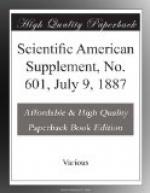This point lies near the middle of the photographic spectrum when a prism is used, and is not far from the H line. The dispersion may accordingly be found with sufficient accuracy by measuring the interval between the H and K lines, and dividing the result in millimeters by 3.4, since the difference in their wave lengths equals this quantity. The following examples serve to illustrate the dispersion expressed in this way: Angstrom, Cornu, 10; Draper, photographer of normal solar spectrum, 3.1 and 5.2; Rowland, 23, 33, and 46; Draper, stellar spectra, 0.16; Huggins, 0.1.
The most rapid plates are needed in this work, other considerations being generally of less importance. Accordingly, the Allen and Rowell extra quick plates have been used until recently. It was found, however, that they were surpassed by the Seed plates No. 21, which were accordingly substituted for them early in December. Recognizing the importance of supplying this demand for the most sensitive plates possible, the Seed Company have recently succeeded in making still more sensitive plates, which we are now using. The limit does not seem to be reached even yet. Plates could easily be handled if the sensitiveness were increased tenfold. A vast increase in the results may be anticipated with each improvement of the plates in this respect. Apparatus for testing plates, which is believed to be much more accurate than that ordinarily employed, is in course of preparation. It is expected that a very precise determination will be made of the rapidity of the plates employed. Makers of very rapid plates are invited to send specimens for trial.
The photographic work has been done by Mr. W.P. Gerrish, who has also rendered important assistance in other parts of the investigation. He has shown great skill in various experiments which have been tried, and in the use of various novel and delicate instruments. Many of the experimental difficulties could not have been overcome but for the untiring skill and perseverance of Mr. George B. Clark, of the firm of Alvan Clark & Sons, by whom all the large instruments have been constructed.
The progress of the various investigations which are to form a part of this work is given below:
1. Catalogue of Spectra of Bright Stars.—This is a continuation of the work undertaken with the aid of an appropriation from the Bache fund, and described in the Memoirs of the American Academy, vol. xi., p. 210. The 8 inch telescope is used, each photograph covering a region of 10 deg. square. The exposures for equatorial stars last for five minutes, and the rate of the clock is such that the spectra have a width of about 0.1 cm. The length of the spectra is about 1.2 cm. for the brighter, and 0.6 cm. for the fainter stars. The dispersion of the scale proposed above is 0.1.




